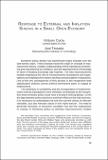| dc.contributor.author | Corbo, Vittorio | |
| dc.contributor.author | Tessada Pinto, José Antonio | |
| dc.date.accessioned | 2019-11-01T00:02:48Z | |
| dc.date.available | 2019-11-01T00:02:48Z | |
| dc.date.issued | 2005 | |
| dc.identifier.isbn | 956-7421-21-8 | |
| dc.identifier.uri | https://hdl.handle.net/20.500.12580/3693 | |
| dc.description | Monetary policy design has experienced major changes over the last twenty years. These changes had their origin in changes in macroeconomic theory, a better understanding of the importance of achieving and maintaining low inflation, and the abandonment of fixed pegs in favor of floating exchange rate regimes. The new macroeconomic models emphasize the role of microeconomic foundations and expectations and highlight the need to develop and strengthen institutions. One of the key consequences of this process is the recognition that stabilization policies cannot achieve permanent gains in output or employment. | |
| dc.format | .pdf | |
| dc.format.extent | Sección o Parte de un Documento | |
| dc.format.medium | p. 29-56 | |
| dc.language.iso | eng | |
| dc.publisher | Banco Central de Chile | |
| dc.relation.ispartof | Series on Central Banking, Analysis, and Economic Policies, no. 9 | |
| dc.rights | Attribution-NonCommercial-NoDerivs 3.0 Chile | * |
| dc.rights.uri | http://creativecommons.org/licenses/by-nc-nd/3.0/cl/ | * |
| dc.subject | INFLACIÓN | es_ES |
| dc.subject | POLÍTICA MONETARIA | es_ES |
| dc.subject | MACROECONOMÍA | es_ES |
| dc.subject | TIPO DE CAMBIO | es_ES |
| dc.title | Response to external and inflation schocks in a small open economy | |
| dc.type.doc | Artículo | |
| dc.file.name | BCCh-sbc-v09-p029_056 | |


